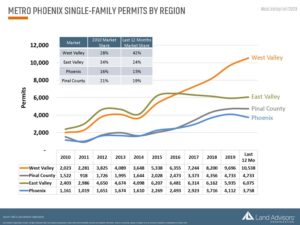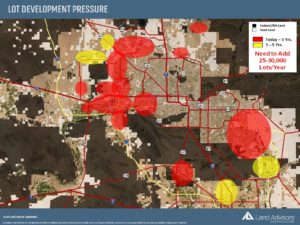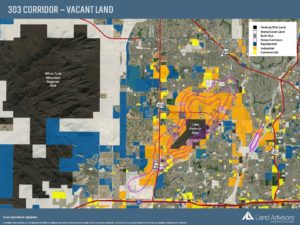“Washington is not a place to live in. The rents are high, the food is bad, the dust is disgusting, and the morals are deplorable. Go West, young man, go West and grow up with the country.” —Horace Greeley, New-York Daily Tribune, July 13, 1865
Myriad master-planned communities. Thriving new businesses. National companies in manufacturing and healthcare. Transportation corridors. Post-secondary educational institutions.
The West Valley is no longer the lightly-talked-about region of Metro Phoenix it once was. It is now home to an expanding population, diverse workforce and booming housing construction.
With the completion of the Loop 303 and the Loop 202 South Mountain Freeway connecting the East Valley to West Phoenix, business leaders, real estate experts and developers throughout Arizona predicted another wave of smart development around the new transportation corridor to continue the region’s strong economic growth.
That prediction has come true.
“It’s exciting to see the amount of activity in the West Valley. We’re seeing a huge demand for everything from commercial to master-planned communities,” Greg Vogel, founder and CEO of Land Advisors Organization, said on the 2020 West Valley Land & Housing Forecast webinar, presented September 9th.
The event was sponsored by Land Advisors Organization and WESTMARC (the Western Maricopa Coalition), a public/private partnership of the 15 communities, business community and educational sector in the West Valley. It was viewed by 200 members of the business community and several West Valley mayors.
WESTMARC CEO Sintra Hoffman shared figures that illustrate the appeal and strength of the West Valley: 3,000 square miles; 1.7 million residents living in a 3,000-square-mile radius; median household income of $57,919; average age, 35.
“The West Valley offers unique assets,” Hoffman said. “Regionalism is all about working with varied communities. We are raising kids here. People are choosing to live in the West Valley. It has been described as having big-city amenities with a small-town feel.”
The West Valley leads Metro Phoenix in numerous home-building categories that range from entry-level to luxury single-family options as well as built-to-rent, according to Vogel. He touts the affordability and value that the West Valley offers because of good, careful planning that provides a wide mix of uses and open space that is popular to those seeking convenient access to recreational space. While some of the data is impressive and jaw-dropping, there are also some figures that are raising concern.
Land transactions have totaled $1.25 billion in the last 12 months alone. There is a need to add 25,000 to 30,000 lots throughout Metro Phoenix each year and the West Valley is predicted to need most of these lots. “There is a lot of migration, particularly from California, and the West Valley is ripe for development,” Vogel said. “Metro Phoenix population is increasing by 90,000 people annually, which indicates a need for 27,000 single-family homes and 8,000 multi-family housing units to be added annually,” he added. According to Vogel, 57% of the demand for new housing is in the West Valley.
The appeal of the West Valley to builders and developers is further evidenced by the 162 planning and zoning applications filed between 2019 and today. “Over the next decade, we anticipate the need for nearly 200,000 new residential housing units in the West Valley to accommodate over 550,000 people moving into the region,” stated Vogel.
However, the region is experiencing a “chronic shortage.” The most telling statistic: There is a 13-day supply of homes selling for $350,000. In comparison, in a normal market, there is a four-month supply; 27 days for all listings.
“The West Valley is dominating the master-planned communities,” Vogel added. “All you have to do is look at the permits pulled in the last 10 to 12 months; about 5,200 inside master-planned communities in the West Valley.”
The takeaways from the webinar also illustrate West Valley muscle:
- The West Valley will continue to capture a larger share of the region’s growth.
- The West Valley will require nearly 200,000 housing units during this decade.
- The West Valley governments are collaborative with a regionalism mindset.
- The West Valley is dominating in new housing, industrial and showing glimpses of commercial office. It is also attracting higher income jobs in proximity to where the talent resides.
- Infrastructure such as transportation and water and wastewater will be the focus this decade.
- The majority of the West Valley’s future growth will be developed in large-scale and high-quality master-planned communities.
Peter Madrid is with Phoenix-based MadridMedia.


















Speak Your Mind
You must be logged in to post a comment.